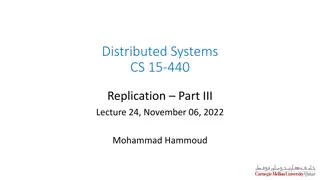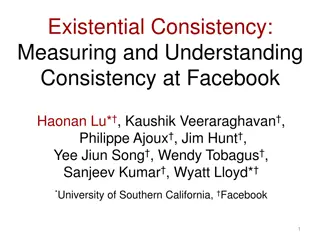Understanding Consistency Models in Distributed Systems
Consistency models in distributed systems define guarantees about how operations are executed across replicas. Linearizability, a key model, ensures that all replicas execute operations in a total order based on real-time ordering. This principle eliminates stale reads and enforces wall-clock ordering for writes. Explore the concept through intuitive examples and grasp how it impacts the behavior of distributed systems.
Download Presentation

Please find below an Image/Link to download the presentation.
The content on the website is provided AS IS for your information and personal use only. It may not be sold, licensed, or shared on other websites without obtaining consent from the author. Download presentation by click this link. If you encounter any issues during the download, it is possible that the publisher has removed the file from their server.
E N D
Presentation Transcript
Consistency Models CS 240: Computing Systems and Concurrency Lecture 15 Marco Canini
Consistency Models Contract between a distributed system and the applications that run on it A consistency model is a set of guarantees made by the distributed system We are concerned with: what happens if a client modifies some data items and concurrently another client reads or modifies the same items possibly at a different replica ?
Linearizability [Herlihy and Wing 1990] All replicas execute operations in some total order That total order preserves the real-time ordering between operations If operation A completes before operation B begins, then A is ordered before B in real-time If neither A nor B completes before the other begins, then there is no real-time order (But there must be some total order) 3
Intuitive example Consistency model defines what values reads are admissible wall-clock time PA: w(x=1) PB: w(x=2) PC: r(x)=? r(x)=? PD: r(x)=? r(x)=? 4
Intuitive example Consistency model defines what values reads are admissible Time when process issues operation wall-clock time PA: w(x=1) PB: w(x=2) PC: r(x)=? r(x)=? Time when process receives response PD: r(x)=? r(x)=? 5
Linearizability Any execution is the same as if all read/write ops were executed in order of wall-clock time at which they were issued Therefore: Reads are never stale (i.e., a read returns the value that was last written) All replicas enforce wall-clock ordering for all writes wall-clock time PA: w(x=1) PB: w(x=2) PC: r(x)=? r(x)=? PD: r(x)=? r(x)=? 6
Linearizability: YES Any execution is the same as if all read/write ops were executed in order of wall-clock time at which they were issued Therefore: Reads are never stale (i.e., a read returns the value that was last written) All replicas enforce wall-clock ordering for all writes wall-clock time PA: w(x=1) PB: w(x=2) PC: r(x)=2 r(x)=2 PD: r(x)=2 r(x)=2 7
Linearizability: NO Any execution is the same as if all read/write ops were executed in order of wall-clock time at which they were issued Therefore: Reads are never stale (i.e., a read returns the value that was last written) All replicas enforce wall-clock ordering for all writes wall-clock time PA: w(x=1) PB: w(x=2) PC: r(x)=1 r(x)=2 PD: r(x)=2 r(x)=2 8
Linearizability: Quiz If the execution is linearizable, what does PA read here? wall-clock time x originally 0 PA: w(x=1) r(x)=? PB: w(x=2) r(x)=1 PA sees the latest write that took effect on the system (x=2) 9
Linearizability == Appears to be a Single Machine Single machine processes requests one by one in the order it receives them Will receive requests ordered by real-time in that order Will receive all requests in some order Atomic Multicast, Viewstamped Replication, Paxos, and RAFT provide Linearizability Single machine processing incoming requests one at a time also provide Linearizability 10
Linearizability is ideal? Hides the complexity of the underlying distributed system from applications! Easier to write applications Easier to write correct applications But, performance trade-offs 11
Stronger vs weaker consistency Stronger consistency models + Easier to write applications - More guarantees for the system to ensure Results in performance trade-offs Weaker consistency models - Harder to write applications + Fewer guarantees for the system to ensure
Strictly stronger consistency A consistency model A is strictly stronger than B if it allows a strict subset of the behaviors of B Guarantees are strictly stronger
Sequential consistency All replicas execute operations in some total order That total order preserves the process ordering between operations If process P issues operation A before operation B, then A is order before B by the process order If operations A and B are done by different processes then there is no process order between them (But there must be some total order)
Sequential Consistency Appears to be a Single Machine Single machine processes requests one by one in the order it receives them Will receive requests ordered by process order in that order Will receive all requests in some order
Linearizability is strictly stronger than Sequential Consistency Linearizability: total order + real-time ordering Sequential: total order + process ordering Process ordering Real-time ordering
Sequential consistency Sequential = Linearizability real-time ordering 1. All servers execute all ops in some identical sequential order 2. Global ordering preserves each client s own local ordering With concurrent ops, reordering of ops (w.r.t. real- time ordering) acceptable, but all servers must see same order e.g., linearizability cares about time sequential consistency cares about program order
Sequential consistency Any execution is the same as if all read/write ops were executed in some global ordering, and the ops of each client process appear in the program order Therefore: Reads may be stale in terms of real time, but not in logical time Writes are totally ordered according to logical time across all replicas wall-clock time PA: w(x=1) PB: w(x=2) PC: r(x)=? r(x)=? PD: r(x)=? r(x)=? 18
Sequential consistency: YES Any execution is the same as if all read/write ops were executed in some global ordering, and the ops of each client process appear in the program order Therefore: Reads may be stale in terms of real time, but not in logical time Writes are totally ordered according to logical time across all replicas wall-clock time PA: w(x=1) PB: w(x=2) PC: r(x)=2 r(x)=2 PD: r(x)=2 r(x)=2 Also valid with linearizability 19
Sequential consistency: YES Any execution is the same as if all read/write ops were executed in some global ordering, and the ops of each client process appear in the program order Therefore: Reads may be stale in terms of real time, but not in logical time Writes are totally ordered according to logical time across all replicas wall-clock time PA: w(x=1) PB: w(x=2) PC: r(x)=1 r(x)=2 PD: r(x)=2 r(x)=2 Not valid with linearizability 20
Sequential consistency: NO Any execution is the same as if all read/write ops were executed in some global ordering, and the ops of each client process appear in the program order Therefore: Reads may be stale in terms of real time, but not in logical time Writes are totally ordered according to logical time across all replicas wall-clock time PA: w(x=1) PB: w(x=2) PC: r(x)=2 r(x)=1 PD: r(x)=2 r(x)=1 No global ordering can explain these results 21
Sequential consistency: NO Any execution is the same as if all read/write ops were executed in some global ordering, and the ops of each client process appear in the program order Therefore: Reads may be stale in terms of real time, but not in logical time Writes are totally ordered according to logical time across all replicas wall-clock time PA: w(x=1) w(x=3) PB: w(x=2) PC: r(x)=3 r(x)=1 PD: r(x)=2 r(x)=1 No sequentialglobal ordering can explain these results E.g.: w(x=3), r(x)=3, r(x)=1, w(x=2) doesn t preserve PA s ordering 22
Consistency hierarchy Linearizability e.g., RAFT Sequential Consistency e.g., Bayou Causal+ Consistency Eventual Consistency e.g., Dynamo
Causal+ Consistency Partially orders all operations, does not totally order them Does not look like a single machine Guarantees For each process, an order of all writes + that process s reads Order respects the happens-before ( ) ordering of operations + in Causal+ means replicas converge to the same state Skip details, makes it stronger than eventual consistency
Causal Consistency 1. Writes that are potentially causally related must be seen by all processes in same order 2. Concurrent writes may be seen in a different order on different processes Concurrent: Ops not causally related
Causal Consistency 1. Writes that are potentially causally related must be seen by all processes in same order PA PC PB a b f c 2. Concurrent writes may be seen in a different order on different processes d e g Concurrent: Ops not causally related Physical time
Causal Consistency PA PC PB Operations Concurrent? a b a, b N f b, f Y c c, f Y d e, f Y e e, g N g a, c Y a, e N Physical time
Causal Consistency PA PC PB Operations Concurrent? a b a, b N f b, f Y c c, f Y d e, f Y e e, g N g a, c Y a, e N Physical time
Causal+ But Not Sequential PA r(y)=0 w(x=1) PB w(y=1) r(x)=0 Casual+ X Sequential w(x=1) r(y)=0 Happens Before Order w(x=1) r(y)=0 Process Ordering w(y=1) r(x)=0 w(y=1) r(x)=0 PA Order: w(x=1), r(y=0), w(y=1) w(x=1) r(y)=0 No Total Order PB Order: w(y=1), r(x=0), w(x=1) w(y=1) r(x)=0
Eventual But Not Causal+ PA w(y=1) w(x=1) PB r(y)=1 r(x)=0 Eventual X Causal+ As long as PB eventually would see r(x)=1 this is fine w(x=1) w(y)=1 Happens Before Ordering r(y)=1 r(x)=0 w(x=1) w(y)=1 No Order for PB r(y)=1 r(x)=0
Summary: Consistency hierarchy Linearizability e.g., RAFT Sequential Consistency e.g., Bayou Causal+ Consistency Eventual Consistency e.g., Dynamo
Causal Consistency: Quiz PA PB PC w(x=1) w(x=3) r(x)=1 w(x=2) r(x)=3 r(x)=2 PD r(x)=2 r(x)=3 Valid under causal consistency Why? x=3 and x=2 are concurrent So all processes don t (need to) see them in same order PC and PDread the values 1 and 2 in order as potentially causally related. No causality for 3 .
Sequential Consistency: Quiz PA PB PC w(x=1) w(x=3) r(x)=1 w(x=2) r(x)=3 r(x)=2 PD r(x)=2 r(x)=3 Invalid under sequential consistency Why? PC and PD see 2 and 3 in different order But fine for causal consistency 2 and 3 are not causally related
Causal Consistency PA PB PC w(x=1) r(x)=1 w(x=2) r(x)=2 r(x)=1 PD r(x)=1 r(x)=2 x x=2 happens after x=1
Causal Consistency PA PB PC w(x=1) w(x=2) r(x)=2 r(x)=1 PD r(x)=1 r(x)=2 PBdoesn t read value of 1 before writing 2
Visualization of linearizability Nice way to see and think when a certain execution is / isn t allowed in linearizability https://mwhittaker.github.io/consistency_in_distributed_systems/2_cap.html Also check out: https://mwhittaker.github.io/blog/visualizing_linearizability/ https://muratbuffalo.blogspot.com/2021/10/linearizability.html 36























